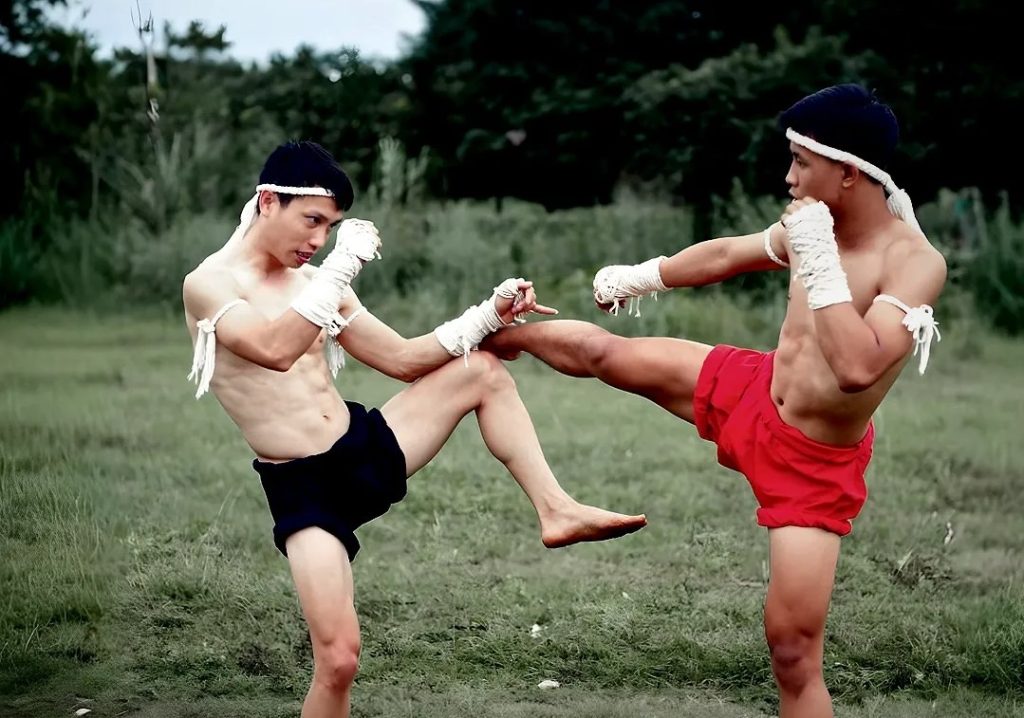Muay Thai, often referred to as the “Art of Eight Limbs,” is a powerful and versatile martial art originating from Thailand. It incorporates punches, kicks, elbows, and knees, making it one of the most effective striking arts in the world. Whether you’re looking to get fit, learn self-defense, or compete professionally, starting Muay Thai is a rewarding journey.
Table of Contents
This comprehensive guide will walk you through everything you need to know to begin your Muay Thai training—from gear and training structure to basic techniques and diet.
1. Understanding Muay Thai Basics
| Element | Description |
|---|---|
| Striking | Uses 8 points of contact: fists, elbows, knees, and shins |
| Clinch | Close-range grappling used for control and delivering knees/elbows |
| Stance | Square stance for balance, power, and readiness to defend or attack |
| Rhythm | Muay Thai has a flowing, rhythmic movement unlike rigid boxing footwork |
| Respect | Bowing and showing respect is deeply ingrained in Muay Thai culture |
2. Choosing the Right Gym
Finding the right training environment is crucial for your development. A good gym should offer:
- Qualified instructors with competition experience.
- Structured beginner programs.
- Friendly, inclusive atmosphere.
- Clean facilities with quality equipment.
If possible, take a trial class before committing. Here’s what to look for:
| Checklist Item | What to Look For |
|---|---|
| Instructor credentials | Fights/training history, ability to teach beginners |
| Training atmosphere | Supportive, disciplined, welcoming |
| Training variety | Includes bag work, pad work, sparring, strength training |
| Class size | Smaller classes = more individual attention |
| Location & schedule | Close to home/work, convenient training times |
3. Essential Muay Thai Gear
You don’t need everything at once, but a few essentials are necessary to train safely and effectively:
| Gear Item | Purpose | Cost Estimate |
|---|---|---|
| Hand Wraps | Protects hands and wrists | $5–10 |
| Boxing Gloves | For pad work, bag work, sparring | $30–100 |
| Shin Guards | Protects shins during kicking drills and sparring | $40–80 |
| Mouthguard | Essential for sparring to protect teeth and jaw | $10–30 |
| Muay Thai Shorts | Allows freedom of movement for kicks and knees | $20–50 |
| Ankle Supports | Optional but helps prevent injuries | $10–20 |
4. What to Expect in Your First Class
Most first-time Muay Thai classes follow a similar structure:
- Warm-up (10–15 min): Jump rope, shadowboxing, or light running.
- Technique Drills (30 min): Learning and practicing strikes or combinations.
- Pad Work (15–20 min): Hitting Thai pads with a partner or coach.
- Conditioning (10–15 min): Bodyweight exercises like push-ups and sit-ups.
- Cool-down/Stretch (5–10 min): Stretching to prevent soreness and injury.
| Time | Activity | Purpose |
|---|---|---|
| 10m | Warm-up | Increase heart rate, loosen joints |
| 30m | Technique | Learn proper form and fundamentals |
| 20m | Pad/Bag Work | Improve power, timing, and combos |
| 15m | Conditioning | Build strength and stamina |
| 10m | Cool-down | Aid recovery, reduce muscle stiffness |
5. Learning the Basic Techniques
Focus on mastering basic techniques before moving to advanced combinations or sparring. Here are key techniques every beginner should learn:
| Technique | Description |
|---|---|
| Jab/Cross | Basic punches used to set up combinations |
| Teep (Front Kick) | A push kick used to keep distance or off-balance opponent |
| Roundhouse Kick | Powerful kick using the shin, typically aimed at legs, body, or head |
| Elbow Strike | Close-range attack, often used in clinch |
| Knee Strike | Thrown from clinch or while advancing |
| Clinch | Controlling opponent’s head/arms to strike or manipulate movement |
Practicing with a coach or experienced partner ensures proper technique, minimizing the risk of injury and bad habits.
6. Conditioning for Muay Thai
Muay Thai requires both cardio endurance and muscular strength. Beginners should focus on:
- Running: Improves cardio and leg strength (3–5 km a few times/week)
- Bodyweight exercises: Push-ups, squats, sit-ups, pull-ups
- Skipping rope: Builds footwork, rhythm, and stamina
| Exercise | Reps/Sets | Purpose |
|---|---|---|
| Push-ups | 3 sets of 15–20 reps | Build upper body strength |
| Squats | 3 sets of 20 reps | Strengthen legs and core |
| Planks | 3 sets of 1 min | Improve core endurance |
| Jump Rope | 10–15 minutes | Footwork, cardio, coordination |
7. Nutrition for Beginners
Eating clean helps with performance and recovery. Focus on:
- Lean protein: Chicken, fish, tofu, eggs
- Complex carbs: Brown rice, oats, whole grains
- Healthy fats: Avocados, nuts, olive oil
- Hydration: Drink water throughout the day and especially during training
| Meal Time | Recommended Food Options |
|---|---|
| Pre-Workout | Banana, oats, Greek yogurt, peanut butter |
| Post-Workout | Grilled chicken, rice, steamed vegetables, protein shake |
| Snacks | Nuts, boiled eggs, fruit, protein bars |
| Fluids | Water, coconut water, electrolyte drinks (during intense training) |
8. Common Mistakes to Avoid
Starting Muay Thai is exciting, but be mindful of these beginner pitfalls:
- Neglecting technique in favor of power.
- Skipping warm-ups or cool-downs, leading to injury.
- Overtraining without allowing your body to recover.
- Comparing yourself to advanced students.
- Wearing improper gear or training without wraps/gloves.
Progress comes from consistency, not perfection. Stay patient.
9. How Often Should You Train?
Beginners can start with 2–3 sessions per week and gradually increase as your body adapts.
| Training Frequency | Goal |
|---|---|
| 2x/week | General fitness, casual skill building |
| 3–4x/week | Steady improvement, preparation for sparring |
| 5–6x/week | Competitive focus, faster progress |
Don’t forget rest days and active recovery like light jogging or yoga.
10. Final Thoughts: The Journey Ahead
Starting Muay Thai can be life-changing. It not only builds physical strength and mental toughness but also instills discipline, humility, and confidence. The key is to show up consistently, listen to your coaches, and enjoy the learning process.
Expect some bruises, sore muscles, and frustrating days. But also expect breakthroughs, new friendships, and a profound respect for a centuries-old art.
Whether you want to fight in the ring or simply improve your fitness, Muay Thai has something for everyone. The hardest part is stepping onto the mat—once you do, the rest is just practice.


